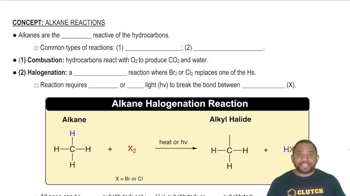Here are the essential concepts you must grasp in order to answer the question correctly.
Balanced Chemical Equation
A balanced chemical equation represents a chemical reaction with equal numbers of each type of atom on both sides of the equation. This ensures the law of conservation of mass is upheld, meaning that matter is neither created nor destroyed during the reaction. To balance an equation, coefficients are adjusted in front of the chemical formulas to achieve this equality.
Recommended video:
Balancing Chemical Equations
Chemical Reaction Types
Chemical reactions can be classified into various types, such as synthesis, decomposition, single replacement, and double replacement. In this case, the reaction of A2 with B to form AB is a synthesis reaction, where two or more reactants combine to form a single product. Understanding the type of reaction helps in predicting the products and balancing the equation.
Recommended video:
Common Types of Alkane Reactions
Equilibrium in Chemical Reactions
Chemical equilibrium occurs when the rates of the forward and reverse reactions are equal, resulting in constant concentrations of reactants and products. In the context of the given reaction, equilibrium indicates that A2 and B are reacting to form AB, but the reaction can also proceed in the reverse direction. Recognizing equilibrium is crucial for understanding the dynamics of the reaction and how it can shift under different conditions.
Recommended video:
Chemical Equilibrium Concepts




